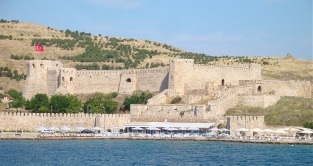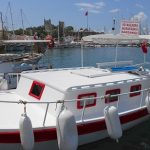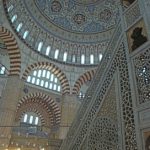Smaller of Turkey’s Aegean islands Population: 5,000
Old name: Tenedos (Greek)
Market day: Wednesday
Festivals: Late June – Wine Days; 26 July Feast of St Paraskevi
When people talk about the Aegean islands they’re normally referring to the myriad Greek islands strung out around the Aegean, some of them considerably closer to Turkey than to Greece. But actually Turkey has two Aegean islands of its own: Bozcaada (the Greek Tenedos) and Gökçeada (the Greek İmbros). Both lie off the coast of the northern Aegean quite close to Çanakkale.
In every other way, it would be hard to think of two places less like each other. Bozcaada is flat and open, its main town picture-postcard in its prettiness while Gökçeada is mountainous and hard to get around, its main settlements huddled defensively on the hilltops well away from each other.
Bozcaada (“the earth-grey island”) is accessible via a ferry ride from Geyikli Harbour. The sailing is short and sweet, with the island clearly visible from the shore so that even the poorest of sailors should be able to stand the crossing. As soon as the boat pulls into harbour you’ll realise that this is one of those dreamy places that you visit intending to stay for a night or so only to find yourself struggling to leave.
Its attractions are immediately obvious: the huge and much patched-up stone castle looming to the right, the line-up of inviting fish restaurants to the left, the lovely old stone houses just a short walk inland. The beaches with their windswept sand dunes are an unexpected bonus. The marina is a relatively new addition.
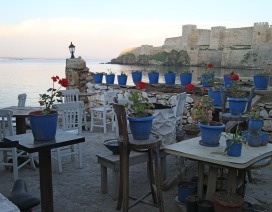
Backstory
Like Gökçeada, Bozcaada has a history that sets it apart from the rest of Turkey. Back in the 19th century it was almost as Greek in nature as the other Aegean islands, a fact that was recognised when the 1923 Treaty of Lausanne exempted its residents from the compulsory population exchange that saw the Greeks of Anatolia “returned” to Greece, their place taken by Turks from Greece. Unfortunately the events of the mid-20th century made it clear to them that there was not much of a future to be had in Turkey, and now the Greek population has shrivelled to a handful of mainly elderly residents.
The Greek heritage explains several things about the island including its boutique wineries, happily flourishing once again after many years in the doldrums.
It also explains the small lokantas with the look of a Greek taverna about them, and the streets of stone houses very like those in Ayvalık that have thankfully survived to be turned into bijou hotels. Poke around and you can still find the old Greek school and several churches together with an abandoned monastery.
Around the island
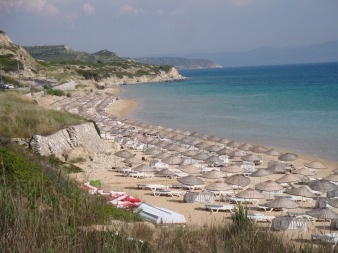 Of Bozcaada’s many assets one is certainly its small size which means that you can easily get around it on foot or by bike. For those of a lazier disposition there are also buses which run across the island to the wonderful sandy beaches of the south around Ayazma, Sulubahçe and Habbele.
Of Bozcaada’s many assets one is certainly its small size which means that you can easily get around it on foot or by bike. For those of a lazier disposition there are also buses which run across the island to the wonderful sandy beaches of the south around Ayazma, Sulubahçe and Habbele.
Just up the hill from Ayazma you can look at (although not enter) the small chapel built above a holy spring (ayazma) that gave its name to the area. Every year on 26 July Greeks come here from their new homes around the world to commemorate the feast day of St Paraskevi with music, dancing and good food.
Due south of Bozcaada Town there’s a lovely secluded bay at Mermerburun where a spit of rock curves out into the sea.
Most visitors stay in Bozcaada Town not only for its convenience but also because it’s a rare example of a Turkish town that has remained virtually untouched since its Ottoman heyday. The same is true of the Çarşı district of Safranbolu, but that was a purely Turkish settlement. Here you’re looking at what was once an example of the famed Ottoman multiculturalism in action, with two communities, one Turkish, the other Greek, living side-by-side in seeming harmony until the political eruptions of the 19th and 20th centuries rendered that harmony unsustainable.
Today the old Greek quarter (to the right as you land) is dominated by the lovely bell tower of the Church of the Dormition of the Mother of God, built in 1869 and rebuilt in 2009, while the Turkish quarter (to the left) spreads out from around the Alaybey Camii which dates, in its present incarnation, from 1702. Here, rather surprisingly, you will find the grave of Halil Hamid Paşa (1736-85), grand vizier to Abdülhamid I who was exiled here and then beheaded for supposedly plotting against him in favour of the future sultan Selim III.
Bozcaada Town is low on specific things to see, especially since the enormous castle is generally kept locked up (as is the church). Not that that matters much since you can admire its magnificent walls and towers just as well from the outside. Although it dates back to Byzantine times, the castle you see today is clearly much later in date and stands as a reminder of the days when first the Genoese and then the Venetians dominated local life. It was finally rebuilt by Mehmed the Conqueror in 1479, which is also when the island’s romantic old Greek name, Tenedos, was dropped in favour of Bozcaada. Restored again recently, it looks sturdy enough to stand up to anything the future might throw at it.
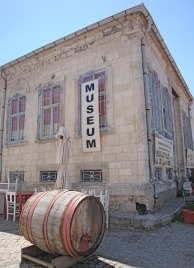 The castle aside, there’s also a small museum that keeps erratic hours but does contain an interesting collection of island artefacts, including a room devoted to the lost Greek population (only an estimated 20-25 Greeks still live on the island). Look out in particular for a photograph of a ruined building with a huge white star carved into its façade. This was St. Theodoros (aka the Yıldızlı Kilise), one of the island’s outlying chapels, which was once tended by the family of writer, Dmetri Kakmi. His Mother Land is required reading for visitors who want to understand the island’s recent history better.
The castle aside, there’s also a small museum that keeps erratic hours but does contain an interesting collection of island artefacts, including a room devoted to the lost Greek population (only an estimated 20-25 Greeks still live on the island). Look out in particular for a photograph of a ruined building with a huge white star carved into its façade. This was St. Theodoros (aka the Yıldızlı Kilise), one of the island’s outlying chapels, which was once tended by the family of writer, Dmetri Kakmi. His Mother Land is required reading for visitors who want to understand the island’s recent history better.
You can also visit the island’s five boutique wineries — Corvus, Talay, Amadeus, Güler and Ada –which all produce admirably quaffable labels.
Alternatively you can just hang about in a cafe relishing the low-key loveliness of island life. 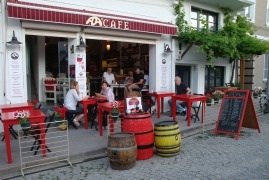
Eating and drinking
The locals tend to patronise the tea-houses in the main square, but for something more than a glass of çay you can always hit Café at Lisa’s, where the gossip tends to be spot on, or the Ada Café, which is the place to come to sample a couple of island specialties: gelincik şerbeti (poppy syrup) and sakızlı kurabiye (mastic-flavoured biscuits).
Fans of the Greek taverna will relish being able to lunch in restaurants that are very like those on the Greek islands. The Lodos and Güverte are the most conspicuous because they’re on the main drag, but you can hardly overlook the Sandal which has half a rowing-boat attached to its wall in homage to its name (sandal is Turkish for rowing boat).
A great alternative, if only in high season, is to head south to Tuzburnu where the hilltop Cez restaurant garners rave reviews.
In the evening the action migrates down to the harbour where the fish restaurants are so tightly packed that it’s hard to tell where one ends and the next begins. In high season prices get ratcheted up to near İstanbul levels so ask first to avoid rude shocks.
Some of the cafes and tavernas only open until mid-September. When deciding the time of a visit, weigh up what is more important to you – maximum choice or fewer people competing for tables. Prices start to fall in mid-September.
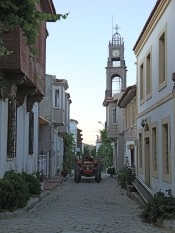 Sleeping
Sleeping
Boutique hotels have blossomed all over Bozcaada which now has some of the nicest accommodation in the country, with the Rengiğul Konukevi and Kaikias Hotel in particular competing to lay on the most splendid breakfasts.
The Ege Hotel Bozcaada is housed in what was the old schoolhouse with bedrooms in the classrooms opening off a long corridor where you can almost hear the ghostly sounds of the children who used to play in it, while the Armagrandi Bozcaada was converted from an old wine-making factory.
If you want to escape the town you can also stay in several excellent farm pansiyons including the Bağbadem Tatil Evi and the Aral Tatil Çiftliği.
Ege Hotel Bozcaada
Akvaryum Hotel www.akvaryumbozcaada.com, Tel: 0532-746 4618,
Aral Tatil Çiftliği www.araltatilciftligi.com Tel: 0286-697 8357,
Ataol Çiftliği www.ataolciftligi.com Tel: 0286-697 0384,
Bağbadem Tatil Evi Tel: 0286-697 8169
Kaikias Hotel www.kaikias.com Tel: 0286-697 0250
Katina Hotel Tel: 0286-697 0242
Rengigül Konukevi Tel: 0286-697 8171
Transport info
Half-a-dozen daily ferries sail from Geyikli İskelesi (Geyikli Harbour) to Bozcaada, with buses leaving Ezine otogar timed to connect with them (get to Ezine by bus from Çanakkale or Ayvacık). Sailings are fewer in winter. For ferry times go to https://www.bozcaadarehberi.com/en/ferry_timetable/.
There are hourly buses across the island from Bozcaada Town to Ayazma. Bikes can be rented to explore the rest of the island
Regular dolmuşes run from Çanakkale otogar to Geyikli İskelesi; if you can’t find a direct bus to the harbour take one to Ezine and change.
If you have to wait around at the harbour there are a couple of tea-houses and a small beach.
